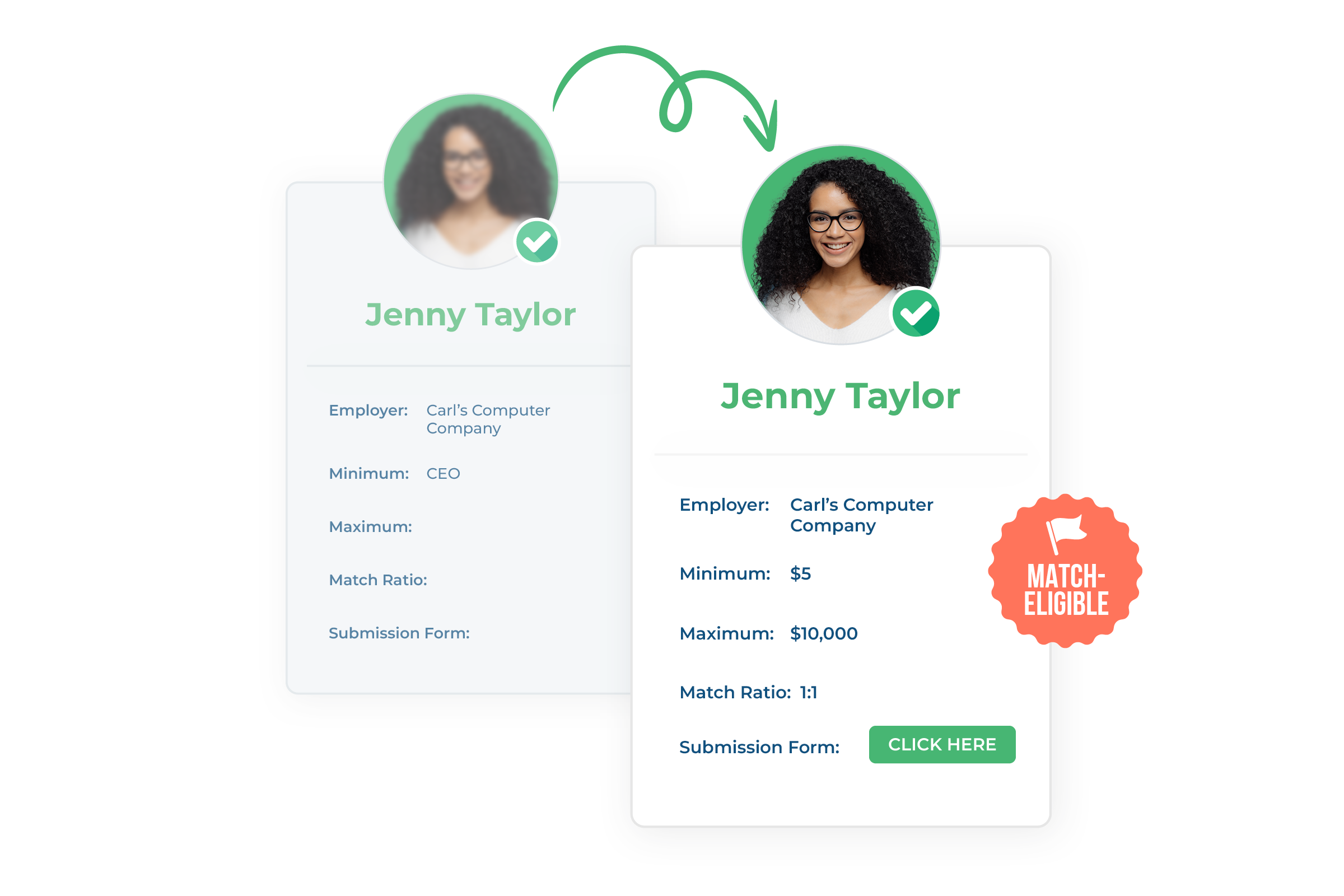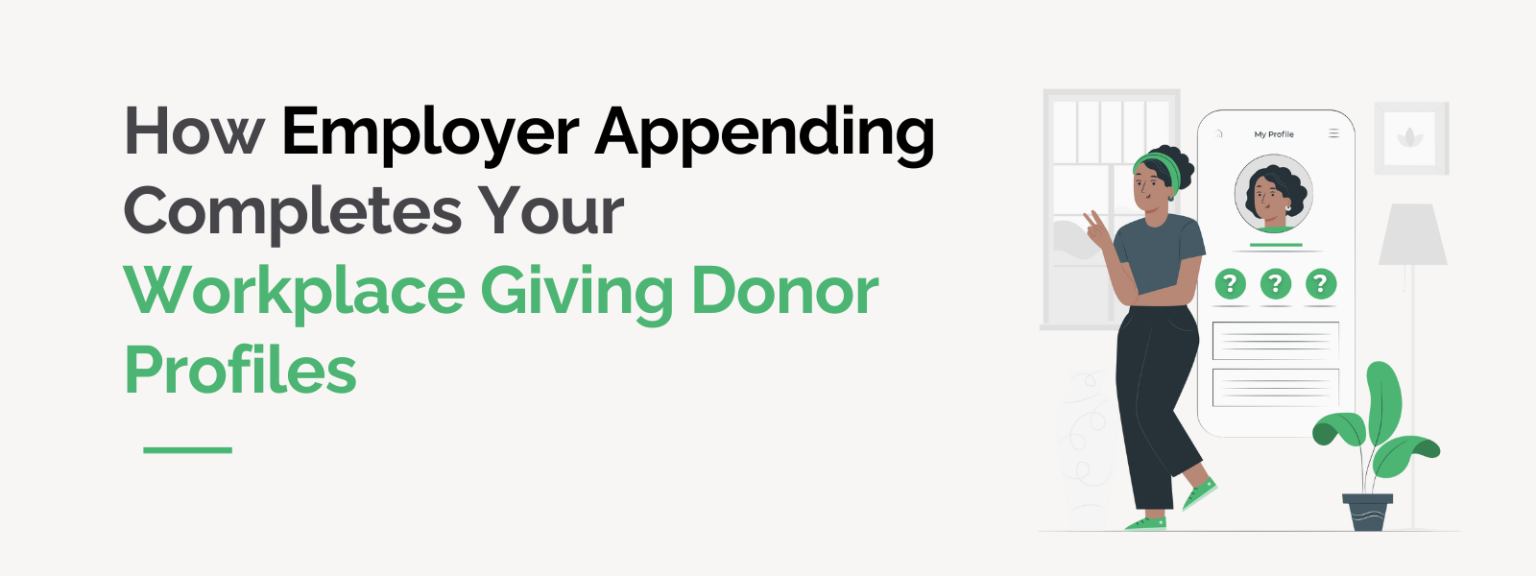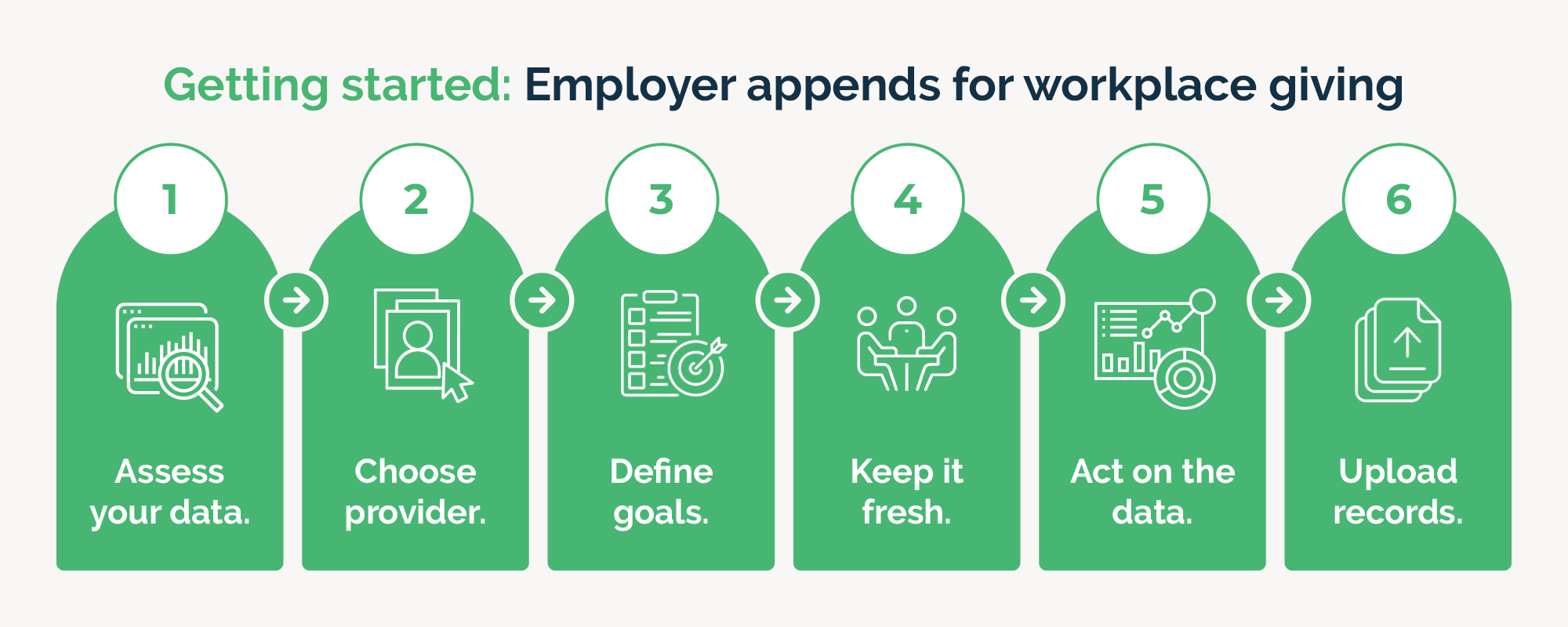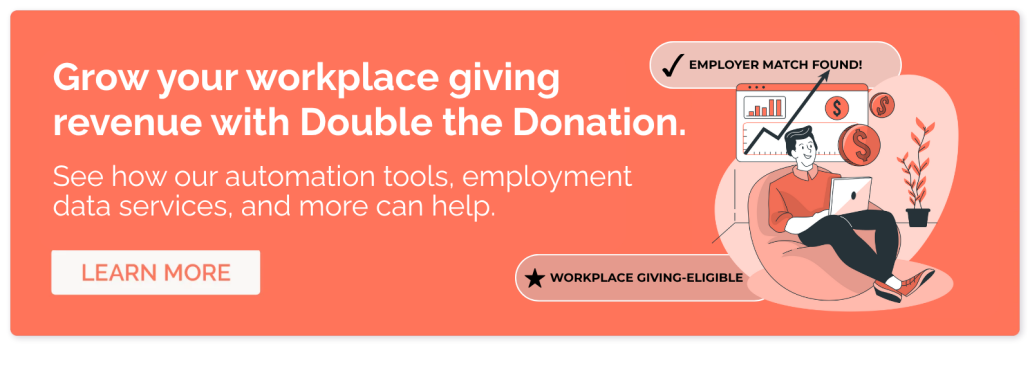How Employer Appending Completes Your Workplace Giving Donor Profiles
When it comes to equipping your team with enhanced workplace giving donor profiles, accurate and complete donor data isn’t just helpful—it’s essential. One of the most overlooked yet powerful pieces of information in your donor database is employer data. After all, knowing where your supporters work can unlock corporate matching gifts, boost campaign targeting, and significantly increase giving potential.
But what happens when this information is missing? That’s where employer appending comes in. This process helps nonprofits fill in the blanks, matching donors with their employers to build more complete, actionable profiles.
In this post, we’ll explore how employer appending works and why it’s a game-changer for enhancing your workplace giving strategy. We’ll cover:
- Why do donor profiles matter for workplace giving?
- How does appending employer data help?
- Getting started with employer appends for workplace giving
Accurate employer data can be the missing link between a good fundraising program and a great one. In the sections ahead, we’ll show you how employer appending strengthens workplace giving donor profiles and empowers your team to make more informed, strategic outreach decisions.
Why do donor profiles matter for workplace giving?
Workplace giving programs thrive on strong engagement, and comprehensive donor profiles are what make that engagement possible. After all, a well-crafted donor profile is more than just a name and email address. It’s a collection of key data points that help your organization understand who your supporters are, how they prefer to give, and even what engagement opportunities are available to them. This information is especially critical when it comes to unlocking the full potential of workplace giving.
Why? One of the most valuable—but often missing—data points in a donor profile is an individual’s employer. And without it, you may be leaving thousands of dollars in matching gifts or volunteer grants unclaimed. However, simply knowing where a donor works allows you to identify their eligibility for corporate giving programs, tailor outreach messages, and segment communications based on employer partnerships or matching opportunities.

In short, complete and accurate workplace giving donor profiles enable your team to:
- Identify workplace giving opportunities like matching gifts, volunteer grants, and payroll giving programs more efficiently
- Increase participation rates by targeting eligible supporters with tailored engagement information
- Strengthen corporate relationships by demonstrating shared support and rallying donors to advocate on your behalf
- Enhance personalization in your appeals and stewardship efforts, demonstrating a deep knowledge of your supporter base
The more you know about your donors—including their employing companies—the more strategic and successful your workplace giving campaigns will be. That’s why maintaining complete profiles isn’t just helpful; it’s mission-critical.
How does appending employer data help?
Appending employer data is a strategic way to strengthen your donor database by filling in one of its most valuable gaps: where your supporters work. This process utilizes extensive third-party data sources to match your donors with their likely employers, based on identifying details such as name, email, or postal address.
The result? Richer, more actionable workplace giving donor profiles that drive greater fundraising impact.
Here’s how employer appending specifically helps your nonprofit:
- It Uncovers Employee Giving Opportunities: Many companies offer employee giving programs, but if you don’t know where your donors work, you can’t alert them to these opportunities. Appending employer data allows you to proactively identify eligible donors and guide them through the participation process.
- It Improves Campaign Segmentation and Personalization: With employer data on hand, you can tailor your messaging to resonate with specific workplace audiences or corporate partners. For example, consider sending targeted emails to employees of a company running a giving campaign or creating custom donation appeals aligned with that employer’s CSR priorities.
- It Fills Data Gaps and Keeps Records Current: Donor records can become outdated quickly, especially if employment changes aren’t captured regularly. Appending services help refresh your data, ensuring your team has the most accurate and complete information to work with.
- It Strengthens Corporate Partnership Opportunities: When you know which companies your donors work for, you gain insight into potential corporate sponsors or partners. This data can help you identify shared connections and demonstrate employee engagement when approaching companies for in-kind donations, sponsorships, grants, or expanded giving initiatives.
In short, employer appending transforms donor records from passive assets into strategic fundraising tools. By providing you with the employer-focused insights you need, it powers more innovative outreach, better workplace giving outcomes, and stronger donor relationships.
Getting started with employer appends for workplace giving
Employer appending can open new doors for workplace giving. Still, like any data-driven initiative, it works best with thoughtful preparation and execution. The process is relatively straightforward, but taking the proper steps up front will ensure you get the most value out of your appended data.
Below is a step-by-step guide to help your nonprofit get started the right way.
1. Assess the Quality of Your Existing Data
Before you begin the appending process, take time to review and clean your current donor database. After all, the success of an employer append depends heavily on the quality of the data you provide. If your records contain outdated contact information, misspellings, duplicate entries, or inconsistent formats, your match rate will likely suffer.
Key actions to take at this step include:
- Removing duplicate records.
- Standardizing naming conventions (e.g., using full names instead of initials).
- Verifying email addresses and mailing addresses.
- Filling in missing fields where possible.
Well-organized donor information not only improves your append results but also helps downstream fundraising and communications efforts. It’s great to start the process with fresh, clean data in order to drive the best results overall.
2. Choose a Trusted Data Append Provider
As it comes to data appending, selecting the right partner for your efforts is crucial. This enables you to avoid common employer appending mistakes and maximize the accuracy, relevance, and long-term value of your workplace giving donor profiles.
For the best results, a reliable append service should use verified and frequently updated employment databases, offer transparent match methodologies, and ensure overall data accuracy and integrity.
What to look for:
- Experience working with nonprofits and schools.
- High match rates and data accuracy guarantees.
- Clear pricing structure—such as flat fee vs. per-match pricing.
- Strong security and confidentiality policies.
- Detailed workplace giving eligibility insights and next steps.
When selecting the right employer appends service, keep in mind that the more actionable the information they provide, the more you’ll be able to do with it for your cause.
3. Define Your Goals and Use Cases
Before diving into the appending process, be sure to clarify why you want to append employer data. The more specific your goals, the easier it will be to measure success and apply the new data effectively.
Common use cases include:
- Identifying and targeting donors eligible for corporate matching gifts.
- Uncovering volunteers who qualify for corporate volunteer incentives.
- Triggering communications to employees of specific companies.
- Discovering potential corporate sponsorship or grant opportunities.
All in all, realizing your goals will also help you prioritize which data fields matter most (company name, job title, industry, location, workplace giving eligibility, etc.), allowing you to adjust your appends process accordingly.
4. Upload and Append Your Donor Records
At this point in the process, it’s time to submit your file to your selected appends provider. Most services accept CSV or Excel files and require only a few basic fields—commonly donor name, email, mailing address, or phone number—for matching purposes.
Here are some tips for a smoother upload:
- Include as many identifiers as possible to increase the accuracy of matches.
- Make sure your data is formatted according to the provider’s guidelines.
- Label fields clearly (e.g., “First Name,” “Last Name,” “Email Address,” etc.).
Once you upload your data file, you’ve done your part! While turnaround times can vary, most providers will return results within a few days to a week.
5. Integrate and Act on the Data
Once your results come back, don’t let the data sit unused. Look for ways to use the appended employer information alongside your workplace giving platform—like Double the Donation—to identify matching gift opportunities, trigger outreach, or prioritize volunteer grant follow-up. The goal is to make the data actionable, fueling segmentation, outreach, and campaigns tied to employer-based giving.
Examples of how to use appended data:
- Send a custom email to donors at companies that offer matching gifts, linking them to their employer’s submission form.
- Create segmented content for existing volunteers who work at companies with volunteer incentive programs, encouraging them to tap into their workplace benefits.
- Organize a payroll giving drive, where you encourage eligible employees to enroll in their companies’ payroll giving programs on your behalf.
- Encourage a supporter who works at a company with an in-kind donation or grant program to advocate for your organization as a potential recipient.
- At the very least, make sure your team understands how to use the new data and update relevant workflows accordingly.
6. Keep It Fresh
Employment data changes frequently—people change jobs, companies merge, and positions shift. To maintain accuracy, plan to run employer appends on a regular basis (every 6 to 12 months is typical).
Check out these tips for ongoing data hygiene:
- Schedule regular audits and data refreshes.
- Encourage supporters to update their employment info on donation forms, volunteer registrations, or email follow-ups.
- Track employer engagement metrics to inform future corporate outreach.
Keeping your workplace giving donor profiles up to date ensures that your campaigns remain relevant and your workplace giving outreach is as effective as possible.
By following these steps, you’ll be well on your way to building a more powerful, data-enriched fundraising program. With stronger employer insights, your team can unlock new corporate giving opportunities, personalize workplace giving outreach, and ultimately raise more for your mission.
Wrapping up & additional workplace giving appends resources
A strong workplace giving program starts with strong donor data. Luckily, employer appending offers nonprofits a smart, efficient way to enrich donor profiles, uncover new workplace giving opportunities, and create increasingly personalized outreach. By simply identifying where your donors work, you can gain valuable insights that fuel deeper engagement and facilitate fundraising success.
If you’re looking to maximize your workplace giving efforts, employer appending is a strategic step you can’t afford to skip. Now is the time to take a closer look at your donor records—and fill in the missing pieces that could make all the difference.
Interested in learning more about employer appends and their impact on workplace giving? Check out the additional resources below:
- The Ultimate Guide to Employer Appends for Fundraisers. Looking to deepen your understanding of employer appends? This comprehensive guide walks you through the entire process—from how employer data is collected to how it’s used to boost donor engagement and matching gift revenue.
- What Your Employer Appends Might Be Missing—and Why it Matters. This article uncovers common gaps in employer appends and the hidden impact they can have on your workplace giving. Learn what to look for, how to spot inaccuracies, and steps you can take to ensure your data is maximized.
- Free Download: Guide to Developing a Workplace Giving Plan. Ready to take your appended employer data to the next level? Download our free guide to building a successful workplace giving plan. This resource provides the tools you need to establish a program that drives results.







